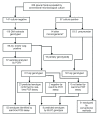Pediatric parapneumonic empyema, Spain
- PMID: 18760005
- PMCID: PMC2603109
- DOI: 10.3201/eid1409.071094
Pediatric parapneumonic empyema, Spain
Abstract
Pediatric parapneumonic empyema (PPE) has been increasing in several countries including Spain. Streptococcus pneumoniae is a major PPE pathogen; however, antimicrobial pretreatment before pleural fluid (PF) sampling frequently results in negative diagnostic cultures, thus greatly underestimating the contribution of pneumococci, especially pneumococci susceptible to antimicrobial agents, to PPE. The study aim was to identify the serotypes and genotypes that cause PPE by using molecular diagnostics and relate these data to disease incidence and severity. A total of 208 children with PPE were prospectively enrolled; blood and PF samples were collected. Pneumococci were detected in 79% of culture-positive and 84% of culture-negative samples. All pneumococci were genotyped by multilocus sequence typing. Serotypes were determined for 111 PPE cases; 48% were serotype 1, of 3 major genotypes previously circulating in Spain. Variance in patient complication rates was statistically significant by serotype. The recent PPE increase is principally due to nonvaccine serotypes, especially the highly invasive serotype 1.
Figures


